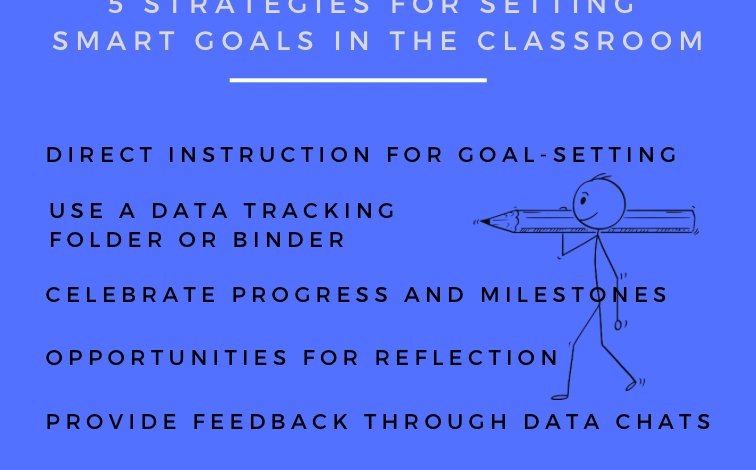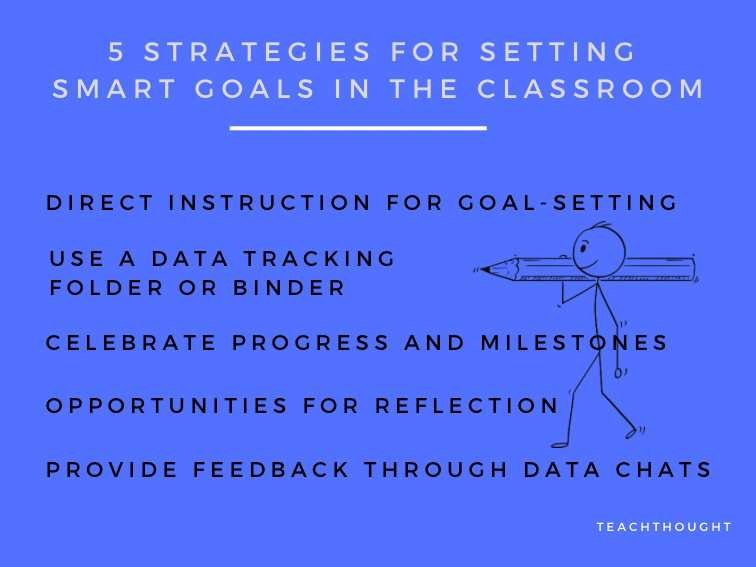5 Strategies For Setting SMART Goals In The Classroom –

Using Goal Setting and Data Tracking to Enhance Student Agency and Achievement
contributed by Samantha Lopez
As educators, we are often referred to as ‘data-driven decision-makers.’
Even in an upper elementary classroom, students can access their grades and keep track of their assignments. Instead of only using data, how can educators show students how to use their own data to make their own decisions about their learning?
The Need for Student Agency
Student agency is students taking ownership of their learning. Often, students from low socioeconomic backgrounds are held to low expectations as an attempt to show compassion from their teachers, minimizing student agency and motivation. Having low expectations of students regardless of their ability allows students to be satisfied with the current performance rather than continuing to strive for growth and improvement.
Williams et al. (2019) discusses students’ lack of effort if they think failure or low performance is likely. Teachers can encourage student agency and avoid stagnation by holding students to high expectations through goal setting and data tracking to account for progress towards the desired goals. This, in turn, increases achievement and student motivation.
Goal-Setting to Increase Student Achievement
Goal setting gives students a clear idea of where they are headed and what they are working towards in the classroom. Teaching students how to make specific, measurable, attainable, relevant, and timely (SMART) goals aids them in focusing their efforts towards improvement and increased achievement. By setting SMART goals, students can determine action steps to help them achieve their goals.
Goals are not limited to academics and can be applied to other areas of students’ lives to get them to commit to goal setting. Within the classroom, goals can be related to getting certain grades, mastering a concept, or learning a new skill. Teachers should provide examples of SMART goals to guide students in their goal-setting. Students can set short-term or long-term goals to provide a clear path towards accomplishment and improvement.
Benefits of Data Tracking for Students
With students in poverty, learned helplessness occurs when students believe they have no control over situations (Jensen, 2009). Learned helplessness is significant because it allows students to remain unmotivated if they realize they cannot change their situation (Jensen, 2009). Using data-tracking and engagement in data-chats allows students to identify areas of strengths and weaknesses and create attainable steps to reach their goals, combating learned helplessness. It also provides students with evidence of their progress, making them more motivated and resilient when faced with academic challenges.

5 Strategies For Setting SMART Goals In The Classroom
- Direct Instruction for Goal-Setting
Teach students how to make SMART goals and provide examples of attainable goals relevant to their decided purpose of learning. In my classroom, I used a SMART graphic organizer I had created. I asked the students to write what each letter in the acronym stood for. Then, I helped the students create a question for each letter.
- For S, the students wrote ‘specific’ and asked, “What do I want to do?” For example, in my reading class, many goals focus on improving spelling, reading comprehension, or vocabulary.
- For M, the students wrote ‘measureable’ and wrote the question, “How can I measure if I accomplished my goal?”. An example is “scoring at least an 80% on 4 out of 7 vocabulary tests.”
- For A, the students wrote ‘attainable’ and asked, “Am I able to reach my goal?” I explained to students that they would have to review their goal and decide if it was attainable or achievable. I gave the example of setting a goal to become an Olympic swimmer if I don’t know how to swim when I am 80.
- For R, the students wrote ‘relevant’ and wrote the question, “Does my goal have to do with this class?” While students can set many goals, I wanted them to keep it on topic. I only teach reading, so I explained that if they set an athletic or math goal, their goal was irrelevant to my class.
- For T, the students wrote ‘time-bound, and wrote the question, “How long do I have to achieve my goal?”. I had students write examples of time-bound, such as “by the end of the quarter” compared to “by the end of the school year.”
After completing the graphic organizer, I model the creation of a SMART goal. Then, with the help of my students, I create an example. Since I am in an elementary classroom, I provide a list of ideas for students to choose from to curate their own goals.
An Examples Of Goal Setting For Teachers And Students
One example we created is “I want to improve my vocabulary (S) by studying daily to score a 90% on the first 5 vocabulary tests (M) by the end of quarter one (T).” Following the creation of the goal, I encouraged the students to ask themselves if they will be able to reach this goal and if it is relevant to reading class. At the very bottom of the graphic organizer, I created a spot for students to brainstorm how to achieve their goals. Some suggestions included meeting with the teacher, studying daily, planning, reading more books, asking questions, using anchor charts, and taking notes to review at home.
- Usage of Data Tracking Folder or Binder
A folder or binder for data tracking allows students to compile their data collection throughout the school year. Students will have one place to refer to their data for reflection and can easily track their progress. My data tracking folder has a spot for students to draw a bar graph based on their state or standardized test scores.
Additionally, it has a data tracking sheet for classwork, quizzes, and tests where students can write in the name of the assignment, the date, the score they received, and color the score on a bar graph. It also has any data chat sheets completed with the teacher or peers.
- Provide Feedback through Data Chats
Teachers should collaborate with students to identify areas of strength and weakness and determine action steps to achieve goals. Teachers need to provide positive, intentional, and constructive feedback to aid students in accomplishing their goals.
Some examples of areas of strength or weakness include vocabulary, literary reading comprehension, informational reading comprehension, phonics, or spelling. Teachers should help students think of ways to improve their weaknesses. After modeling for students, teachers should encourage students to collaborate with their peers, who can serve as an alternative opinion.
- Opportunities for Reflection
With their work in one place, students can use their past and present data collection points to reflect on what is working and not working for them with their learning. Students will become more self-aware of what they need to be successful in the classroom. Teachers should provide students with opportunities to think about their performance like with a data chat. Teachers can also create writing prompts asking students what is working for them with their learning, what else they would need to be successful in the classroom, and what changes should be made.
- Celebrate Progress and Milestones
Positive reinforcement through celebrating accomplishments increases student motivation, fights learned helplessness and pushes students to continue working towards new goals. It helps students feel seen and recognize that their hard work is paying off. For my classes, I’ve done a prize box, popsicle parties, and pizza parties.
Conclusion
Teachers can aid students in increasing their achievement within the classroom by showing them how to create long-term or short-term goals. Students can become active participants in their learning through goal-setting and data tracking.
Goal setting and data tracking encourage student persistence and adaptation when challenges arise, enhance student agency, increase student achievement, and increase student motivation by giving tangible evidence of progress in the classroom. These strategies empower students to decide how to progress their education and increase their self-awareness of how they learn best.
References
Jensen, E. (2009). Teaching with Poverty in Mind: What Being Poor Does to Kids’ Brains and
What Schools Can Do About It. ASCD. 132-133.
Williams, Greenleaf, A. T., Barnes, E. F., & Scott, T. R. (2019). High-achieving, low-income
Students’ Perspectives of How Schools Can Promote the Academic Achievement of Students Living in Poverty. Improving Schools, 22(3), 224–236.
Source link



